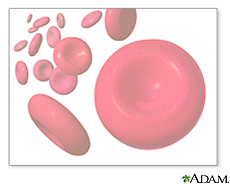 |
 |
 |
Other Health Topics:

-
Related Topics
-
Go Local
- Services and providers for Triglycerides in the U.S.
-
National Institutes of Health
- The primary NIH organization for research on Triglycerides is the National Heart, Lung, and Blood Institute
Triglycerides
Triglycerides are a type of fat in the bloodstream and fat tissue. Too much of this type of fat can contribute to the hardening and narrowing of your arteries. This puts you at risk of having a heart attack or stroke. Diseases such as diabetes, obesity, kidney failure or alcoholism can cause high triglycerides. Often, high triglycerides occur along with high levels of cholesterol, another type of fat.
Triglycerides are measured along with cholesterol as part of a blood test. Normal triglyceride levels are below 150. Levels above 200 are high. If your triglyceride level is high, you can lower it by
- Getting medical treatment for the problem causing the high triglycerides
- Following a healthy diet low in sugars and carbohydrates
- Exercising regularly
- Taking cholesterol-lowering medicines
Start Here
-
Triglycerides
 (National Heart, Lung, and Blood Institute)
(National Heart, Lung, and Blood Institute)
-
Triglycerides(American Heart Association)
Also available in Spanish
| Basics | Learn More | Multimedia & Cool Tools |
|---|---|---|
|
||
| Research | Reference Shelf | For You |
|
-
Overviews
- Patient Information Lipoprotein Risk Factors(National Lipid Association)
- Triglycerides: Why Do They Matter?(Mayo Foundation for Medical Education and Research)
- What Are High Blood Cholesterol and Triglycerides?(American Heart Association) - Links to PDF
-
Diagnosis/Symptoms
- ApoE (Apolipoprotein E) Genotyping(American Association for Clinical Chemistry)
- Lipid Profile(American Association for Clinical Chemistry)
-
Related Issues
- Triglycerides: Common Questions(American Association for Clinical Chemistry)
-
Clinical Trials
- ClinicalTrials.gov: Hyperlipidemias(National Institutes of Health)
-
ClinicalTrials.gov: Hyperlipoproteinemia Type IV
 (National Institutes of Health)
(National Institutes of Health)
-
ClinicalTrials.gov: Hypertriglyceridemia
 (National Institutes of Health)
(National Institutes of Health)
-
Journal Articles
References and abstracts from MEDLINE/PubMed (National Library of Medicine)
- Article: Dietary monounsaturated fat activates metabolic pathways for triglyceride-rich lipoproteins that...
- Article: Nonalcoholic fatty liver disease is associated with hepatic and skeletal...
- Article: Diabetes quiz. How much do you know about triglycerides?
- Triglycerides -- see more articles
- Medical Encyclopedia Return to top
- Organizations Return to top
| Home | Health Topics | Drugs & Supplements | Encyclopedia | Dictionary | News | Directories | Other Resources | |
| Disclaimers | Copyright | Privacy | Accessibility | Quality Guidelines U.S. National Library of Medicine, 8600 Rockville Pike, Bethesda, MD 20894 National Institutes of Health | Department of Health & Human Services |
Date last updated: 26 June 2008 Topic last reviewed: 26 May 2008 |






